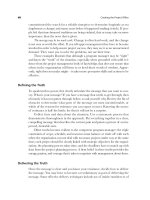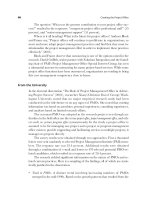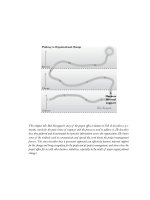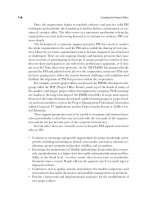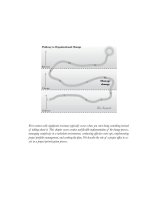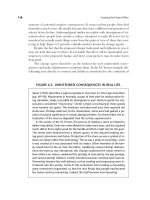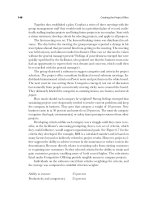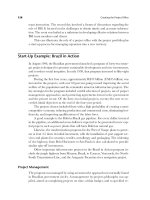Tài liệu Creating the project office 4 pptx
Bạn đang xem bản rút gọn của tài liệu. Xem và tải ngay bản đầy đủ của tài liệu tại đây (115.36 KB, 10 trang )
Some readers may feel like Dante, facing an unknown ordeal to achieve suc-
cess that can only be imagined. Many obstacles appear like beasts along the dark
path. You, too, look for a guide and a way to reach the top of the mountain—and
have found one here. Unlike Dante, however, you will need to enlist others to join
you in the quest; no one can carry a project office alone.
Many organizations have attempted to improve their abilities and project
management over the last decade. Much of this attempt met with limited success.
People were sent out to be trained as project managers, only to find that when
they returned to the organization they were not allowed to perform in the way
they were trained. As people and organizations discovered that the individual
training approach was not leading to improvements, there arose a movement
where a person or group of people in the organization were charged with, or
charged up about, systematically improving project management practice across
the entire organization, thus helping the organization to change to an enterprise
project management system.
This venturesome group has any number of names, including a Project Man-
agement Initiative or a Project Management Center of Excellence, with the um-
brella name project office currently in vogue. As these groups became successful, they
found that more of their effort was associated with organizational change than
with the practice of project management itself. Thus these groups became pri-
mary change agents, either self-proclaimed or assigned, for the process of imple-
menting enterprise project management.
Many participants in the project office movement were surprised to discover
their role as change agents. Many lamented that to be effective in this role they
should have initiated the office as an organizational change approach in the first
place. This book takes just that approach and assumes that a project office, when
properly implemented, will become a leading vehicle driving the organization to-
ward project-based operations and thus enterprise project management. The book
8 Creating the Project Office
Establish sense of urgency—
clear danger
Leading
Organizational
Change
to PBO
Create guiding coalition—
powerful forces
Develop vision and strategy—
focus
Manage the change—
short-term wins, broad-based action,
consolidate gains
Develop broad-based action—
keep moving, implementing
Make change stick—
new PBO culture
The tale we tell
Communicate the change vision—
tell the tale
Staff and operate—
In or out?
aims at helping develop this group of change agents so that their efforts will be
enthusiastically applied throughout the organization, helping them bring about
real change in the organization and avoid ending up as just another staff group.
This book is written by a combination of consultants and practitioners. As
consultants, the primary authors extract general principles for implementing a
project office and present these in chapters. There are also contributions from
practitioners who are in the trenches, actually running project offices and apply-
ing many of the same general principles. This combination of general principles
and real-life examples—theory with theory-in-practice—present an excellent road
map for future practitioners to use.
The Developing Project Office Movement
Project management has its roots in the construction and engineering trade.
Project management began outside the organization—the original project offices
were in trailers parked out on construction sites. Introduction of PERT charts
ushered project management into organizational settings. The real impetus to de-
veloping project management was its use in software projects and other new prod-
uct development projects. Over time, and probably after a number of resounding
failures, it became evident that project management was an important skill, one
that should be developed in order to avoid future failures. Looking further into
the future, some organizations began to see project management skill as a com-
petitive advantage. Groups were formed to look into the situation and it was at
this point, about the late 1980s and early 1990s, that we began to see project office
groups emerge. This situation, at AT&T, is typical of the period:
A small group of dedicated project managers, who had found each other in
business meetings, conferences and classes, realized that they shared the same
passion for project management. This group decided to band together to
address the prevalent project management issues that existed at that time—
constrained resources, lack of standard process or methodology, little or no
training requirements and inconsistent project performance. They knew that
most project managers in our company were operating within independent
circles, without a consistent way of doing project management. Managers of
project managers were using different criteria to determine what should be
project managed. Very few project managers had much organizational sup-
port and fewer still were trained in project management. Most, when they did
act as project managers, had it as a secondary job function [Schneidmuller and
Balaban, 2000, p. 1].
Leading Organizational Change 9
Things were similar in other organizations that addressed project manage-
ment problems. Most people became project manager by accident, and they were
appointed to the task because they had time available, not because they had any
particular project management skill. Projects were not run using any consistent
methodology, if they were using any methodology at all. This lack of project man-
agement skill, methodology, and organizational support led to most projects’ being
late, over budget, and not done to customer satisfaction.
To combat this problem, groups arose such as the Project Management Ini-
tiative at HP, described in Chapter 9 of Graham and Englund (1997). This group
was specific to the engineering function and concentrated mainly on new prod-
uct development projects, so others arose in other divisions, such as the project of-
fice developed for HP Consulting, described here in Chapter Seven. In addition,
more organization-wide groups emerged, such as the Project Management Spe-
cial Interest Group (PMSIG) at 3M, described in Chapter Five, and the Project
Management Center of Excellence at IBM, AT&T, and NCR, to name a few.
This movement to develop project offices is also spreading worldwide. The Star
Alliance, involving United and a dozen or so other airlines is one case, as is Em-
braer, a leading airliner manufacturer in Brazil.
Project office development is also happening across the organization, because
the enterprise project management concept can be applied to a business unit, a
department, or an entire corporation. It is useful to think of it in terms of levels
and typical names:
Level 1 Project level Project Control Office (PCO)
Level 2 Division or department level Project or Program Office
Project Management Center
of Excellence (PMCOE)
Level 3 Corporate level Strategic Project Office (SPO)
Thus as long as there is a multifunctional environment that requires the si-
multaneous management of numerous projects, the concept remains valid. This
means that an IT department could well use such an approach and continue to
interface with the rest of the functional organization even if the corporation did
not undergo a full conversion to the concept. At the lowest level one can find
project offices devoted to one large project or one program. These project office
groups can also be designed to work in one department, for one division, or for
one geographic location. At the highest level we find project office groups at-
tempting to change management practices throughout the entire organization.
10 Creating the Project Office
This highest-level group, the strategic project office, is the one that has the
best chance for directing real organizational change. It is toward this group that
this book ultimately aims. However, since project offices normally evolve toward
that highest level rather than start there, we describe all types of offices and change
processes involved in the evolution to the strategic or organization-wide project
office. We also offer specific steps and skills that individual change agents can apply
to improve personal effectiveness.
The roadblocks for moving an organization project-ward are invariably the
stakeholders. Although lack of resources can also be an obstacle, people present
the major challenges. Principal stakeholders for enterprise project management
implementation are top management, project managers and team members, func-
tional managers, internal change agents, and consulting support personnel (in-
ternal or external). If the initiative is top-down, starting with upper management,
then the effort of getting buy-in from the rest of the organization must be taken
on. If, on the other hand, the idea is filtering from the bottom upward, the some-
times monumental task of getting top management to provide support for the ef-
fort calls for skillful articulation and great persistence. In this book, we present a
change process that begins at the bottom and concentrates on developing project
management capabilities within one part of the organization, then later relying
on a top-down approach to spread those capabilities organization-wide.
Failure in implementing a project office is generally triggered by a combina-
tion of factors such as lack of top management support, underestimating the scope
of organizational change necessary, lack of methodology for managing projects,
insufficient efforts for developing competent project professionals, bad timing, and
inadequate management of the change process. Any one of these factors is
enough to set askew an effort to implement the enterprise project management
concept. However, people who have had difficulties with project office imple-
mentation usually say they should have taken a change management approach
from the beginning. That is, they usually began by concentrating on the functions
of the office itself rather than on the change process necessary to implement such
an office. This book examines the implementation processes of successful offices
and uses that approach to develop a general framework for success.
Organizational Life Cycles and
Approaches to Planned Change
To understand the need for organizational change, it is instructive to look at a typ-
ical organization life cycle. To an outsider, an organization may look to be in a con-
stant state of change. Much of the change in organizations can be seen as random
Leading Organizational Change 11
shifts or reactions to competitor’s product changes. Occasionally, however, orga-
nizations need planned change. The reasoning behind that suggestion is some-
thing like this. Organizations typically exploit new technology to help solve
problems. As these organizations grow they institute policies and procedures that
help them solve problems, both internal problems and problems of external cus-
tomers they serve. If these policies, procedures, or general ways of doing things
are successful, then the organization itself is successful and thrives. Over time,
however, customers’ problems change. For the organization to continue to thrive,
it must change the solution procedures or search for customers who have the old
problems that it can solve. At some point the pool of people with the old prob-
lems dries up. When that happens the organization will be forced to change its
solution processes to solve the new problems or else cease to exist. And that is
when the organization needs deliberate change processes. Many organizations
find themselves in this position today as they move toward enterprise project
management.
This need to change to more project-based procedures has recently emerged
as a necessary change in the life cycles of many organizations because more of
their work has become project work. As mentioned earlier, organizations began
by instituting procedures to solve particular problems, normally repeated proce-
dures aimed at producing standard products. Since these organizations have sur-
vived, we know that these procedures worked to solve the problems they faced.
These procedures were later refined, enlarged, and taught to succeeding genera-
tions of workers so that the organization could enjoy the economies of scale. Pro-
cedures for developing new products or custom-made products were often
haphazard as these products were usually considered to be one-offs and were a
very small part of the organization’s business. Over time, however, this changed
dramatically for most organizations. The commercial life span of most standard
products declined rapidly, giving rise to the need for project management in the
new product development process. Custom-made products or systems solutions
became the norm rather than the exception, giving rise to the need for project
management in the product production process. This change was accompanied
by the rise in the use of computers and the need for computer software and all
aspects of organizational function, giving rise to the need for project management
in the software development process. Changes in the environment, changes in cus-
tomer expectations, and changes in the technology used in organizational
processes have brought many organizations to the point where up to 80 percent
of their work is project work rather than repeat process work. These organiza-
tions are at the point in their life cycles where they need planned organizational
change to become project-based enterprises.
12 Creating the Project Office
Planned organizational changes involve a conscious process with a specified
leader, specified goals, and a time line. That is, it is itself a project, and the project
manager should be the person in charge of implementing the project office. The
overall goal of organizational change is to institute new processes and procedures
that make enterprise project management the norm for the organization. The
time line will depend on many factors including the age of the organization, how
deeply ingrained its current procedures are, the degree of threat the organization
faces, and the amount of support given by top management. In most large orga-
nizations this process can easily span three to five or even ten years.
Roles in the Change Process
Four key roles must be played effectively in implementing change fully and
successfully:
• Sponsors: These are people who legitimize the change. They have the political
and economic resources required to initiate and sustain a change project in an
organization.
• Change agents: These people are responsible, with the sponsor’s approval, for
planning and executing the change project. Most of their activities focus on
the targets of the change.
• Targets: These are the people who must alter the way they work as a result of
the change. Targets are extremely important and active players in the imple-
mentation process.
• Advocates: These are the people who would like to see a change project idea hap-
pen but are not in a position to sponsor it. They, in effect, have a project and
want to identify potential sponsors and persuade them to initiate it.
From our experience, the move toward enterprise project management nor-
mally begins with a group of advocates, a group of dedicated people in the orga-
nization who want to improve project management. On rarer occasions, the
movement is initiated by an upper management sponsor. If the quest is begun by
advocates, it quickly becomes imperative for them to find an upper management
sponsor, someone with enough clout to bring about organizational change. The
change agents are that small group of the most zealous advocates who become
members of the original project office. This group often consists of practicing
project managers who want to spread the good word of project management
throughout the organization. The targets are usually other project managers, then
project team members, and finally all members of the organization.
Leading Organizational Change 13
Organizational Change Versus Reorganization
Planned organizational change should not be confused with reorganization. When
most people think of organizational change they think of the recurring “reorg,”
where departments are shuffled and lines redrawn on the organization chart. Par-
ticipants in this seemingly annual ritual soon recognize that reorganization itself
rarely results in real behavioral change. The usual result is that the same people
sit in different seats but produce the same products by the same processes and for
the same customers.
Reorganizations are wonderful for creating the illusion of progress while en-
suring that nothing fundamentally changes. It is an attempt to get something for
nothing—a feeling of the pleasure of progress without having to go through any
of the pain associated with real change. Reorganizations are so closely associated
with organizational change that those charged with such changes are tempted to
reach for the organization chart first thing. In fact, a reorganization is probably
the last step in any change process, a step taken to solidify changes already in
place.
It is far more effective to eschew attacking the organization chart and instead
begin by determining what needs to be done to develop real change in organiza-
tions. You can get any change process off to a good start by assembling a group of
people who want to change, having them demonstrate how the change is good for
the organization, and then working to have this change adopted throughout the
organization. We call this the “Quaker” approach to organizational change (En-
glund and Graham, 2001). The successful movement to develop project offices will
eventually lead to radical change in organization practices. As with any radical
change process, those in the vanguard—the people implementing the offices—will
often feel like missionaries introducing new practices into a hostile environment.
Early missionaries found it difficult to get other people to change their ways, and
some of them suffered mightily from the wrath of people they were trying to
change. Legends tell us how quiet, nonthreatening Quakers found a better way.
Many missionaries used a heavy-handed, command-oriented approach.
Proud native peoples rebelled and many missionaries were killed. The Quakers,
however, set up farms and produced bountiful harvests. When hungry natives saw
evidence of a rich harvest, they came to ask, “How do you produce such bounty?”
Educating the indigenous peoples to new agricultural ways was much easier once
the benefits were clear.
Business examples present similar stories: Dell Computer versus third-party
retailers . . . Southwest Airlines’ customer-oriented culture . . . eBay and person-
14 Creating the Project Office
to-person Web sales. These companies succeeded in demonstrating how a new
concept can work.
Given the changes that a project office will cause in an organization, it is es-
sential that the approach to developing the office be aligned with organizational
culture. Much of the work of the project office can be seen as missionary work—
trying to convince people they will be better off if they change to new ways. The
metaphor of the Quakers’ good-neighbor approach to organizational change is
a valuable reference point to consider. It is one end of a continuum about how to
implement a project office, shown in Figure 1.1.
The other end of the continuum is the old hierarchical, command-and-con-
trol, “Attila,” do-what-I-say approach. Attila the Hun, as a leader, was able to get
people to do what he commanded, mainly through his aggressive, ambitious, and
arrogant nature. He was a savage conqueror who compelled those not destroyed
by combat to serve in his armies. He delighted in war and became a prudent and
successful general. He caused vast suffering and died, somewhat questionably, be-
fore his invasion plans could be carried out.
Many nineteenth-century industrialists built organizations designed to trans-
mit orders from the top. This worked very well in its day, generating unprece-
dented prosperity across a broad spectrum of society, but has become less effective
as the pace of change has increased in the modern world.
Change agents and their sponsors can determine their place on this continuum,
usually by honoring the existing culture. Design a plan that lines up with the cur-
rent position and then aim to shift direction over time. A hybrid strategy may be
very effective—start with a grassroots small success that is comfortable for everyone
concerned and then enlist upper management support to mandate its use across the
organization. See Figure 1.2 for a more academic treatment of change initiatives.
Leading Organizational Change 15
Attila
Command and control
• Demand
• Force
• Standardize
Quaker
Good neighbor
• Get results
• Show benefit
• Honor culture
FIGURE 1.1. A CONTINUUM OF CHANGE
INITIATIVES TO CHOOSE FROM.
Overall Organization Change Process
Much has been written on the process of organizational change. An important
early model of organizational change was given by Kurt Lewin, who formulated
a simple three-step process of unfreeze, change, and then refreeze. Lewin points
out that the people in an organization may be frozen together with a set of as-
sumptions and procedures that were successful in the past. It is very difficult to
change anything that is frozen, so Lewin advises that before a change can take
place in any organization, first take steps to “unfreeze” it. Combining this model
with our own experience, we formed a three-phase approach:
• Creating conditions for change
• Making change happen
• Making change stick
Creating Conditions for Change
Changing behavior requires that organization members first stop doing what they
are doing now. Many members of organizations find this unsettling. It often means
they must abandon practices they have spent years developing. People will not
16 Creating the Project Office
Beer and Nohria (2001) describe two basic types of change initiatives:
Theory E is the creation of economic value, often expressed as increased
shareholder value. Steps of the change plan are crafted and monitored from
above. Leaders focus on strategies, structures, and systems. Financial targets and
incentives dominate the agenda.
Theory O maintains that creating sustainable competitive advantage is the
best means of serving shareholders’ long-term interests. The emphasis is on
building organizational capability—a learning organization—and changing the
culture that creates structures and systems.
Theory E approaches are top-down, centrally planned, and highly program-
matic while Theory O is bottom-up and involves high levels of participation and
emerging cultures.
Fundamental tensions exist between Theories E and O. The challenge is to
combine the best of both.
FIGURE 1.2. THEORY E AND THEORY O.
readily do this unless they thoroughly understand why they are being asked to
make the change and how they will be better off by making that change. The or-
ganizational change agent must be ready to lead the people through these trying
times by showing why the changes are absolutely necessary and also showing peo-
ple how they will be better off by adopting project management practices.
Experience and studies show the two most important factors in successful or-
ganizational change are first that it is supported by the very top of the organiza-
tion and second that the people have a reason why they need to change. People
are much more amenable to change when they understand why it is necessary.
Thus this phase requires the change agents to create a sense of urgency by citing
the clear danger of continuing on the current path, develop a coalition of pow-
erful forces that will help to ensure the necessary support from the top, develop
and communicate a vision of how the changed organization will function, and
develop a strategy for using a project office to achieve that vision.
Making Change Happen
After creating the proper conditions, the change agents institute necessary changes
throughout the entire organization. Here the concentration is on building wide-
spread project management capacity. Much of this change will be accomplished by
developing a set of standard project methodologies, training organization members
on the use of these methodologies, and mentoring project managers and their spon-
sors. However, an equally important aspect of the change will be political. Chang-
ing practices and procedures will also result in a change in the power structure of
the organization, so the change agent must be politically astute and understand the
organizational power structure. During the process of change, one can expect or-
ganizational efficiency to decrease while people learn the new procedures. People
in the old power structure will repeatedly call for a return to the old ways.
Making Change Stick
The final phase in any change process is to refreeze behavior in the new, desired
pattern. This is where changing the organization structure will be most effective.
By this point the increased organizational capacity has shown its value and en-
terprise project management should have the support necessary from the very top
of the organization. Project management will become the way things are done.
Experiences with large organizational change usually show that about a third of
the members of the organization will find it almost impossible to make a change
and will decide to leave the organization instead. This is not an undertaking for
the faint of heart.
Leading Organizational Change 17
